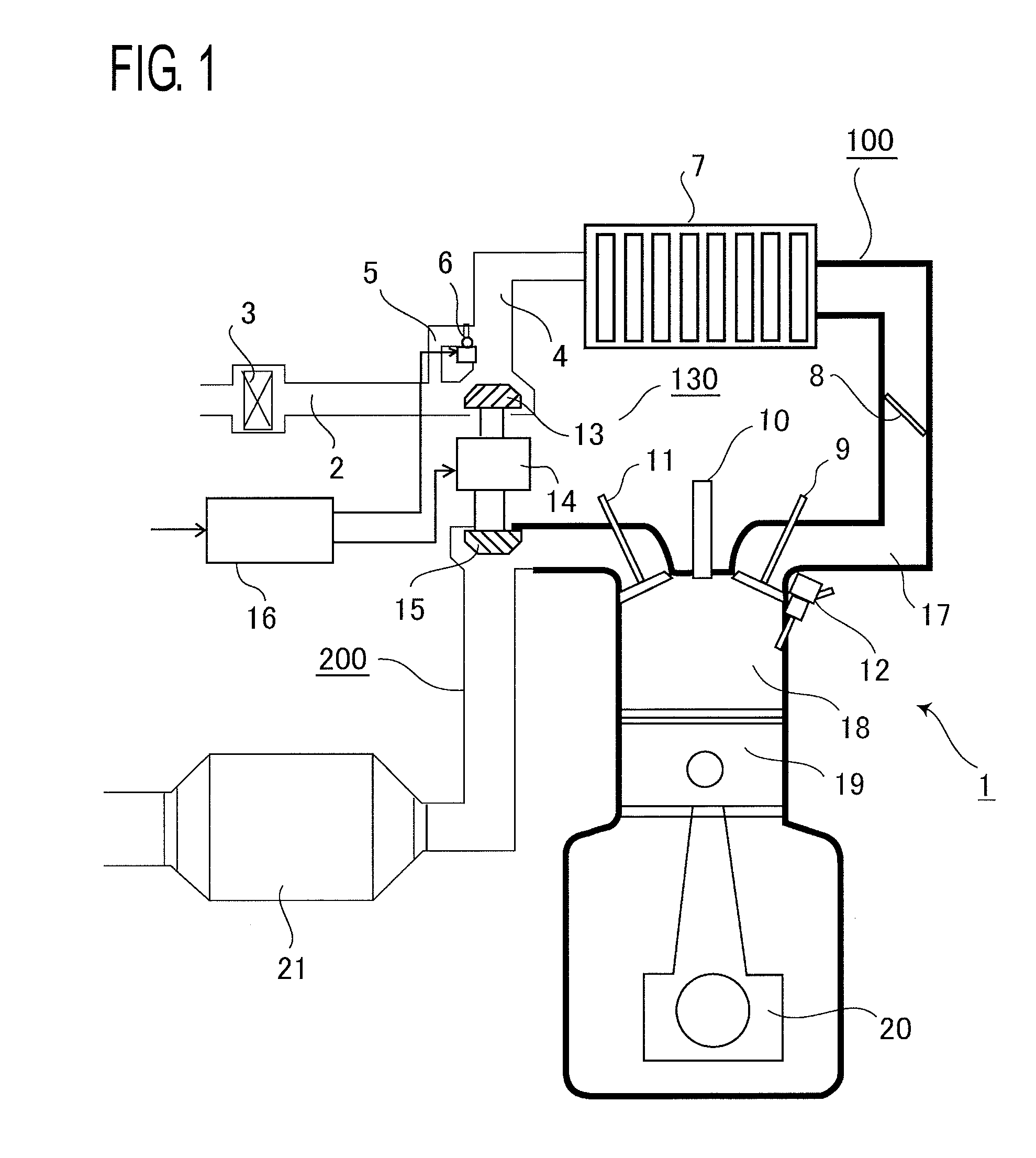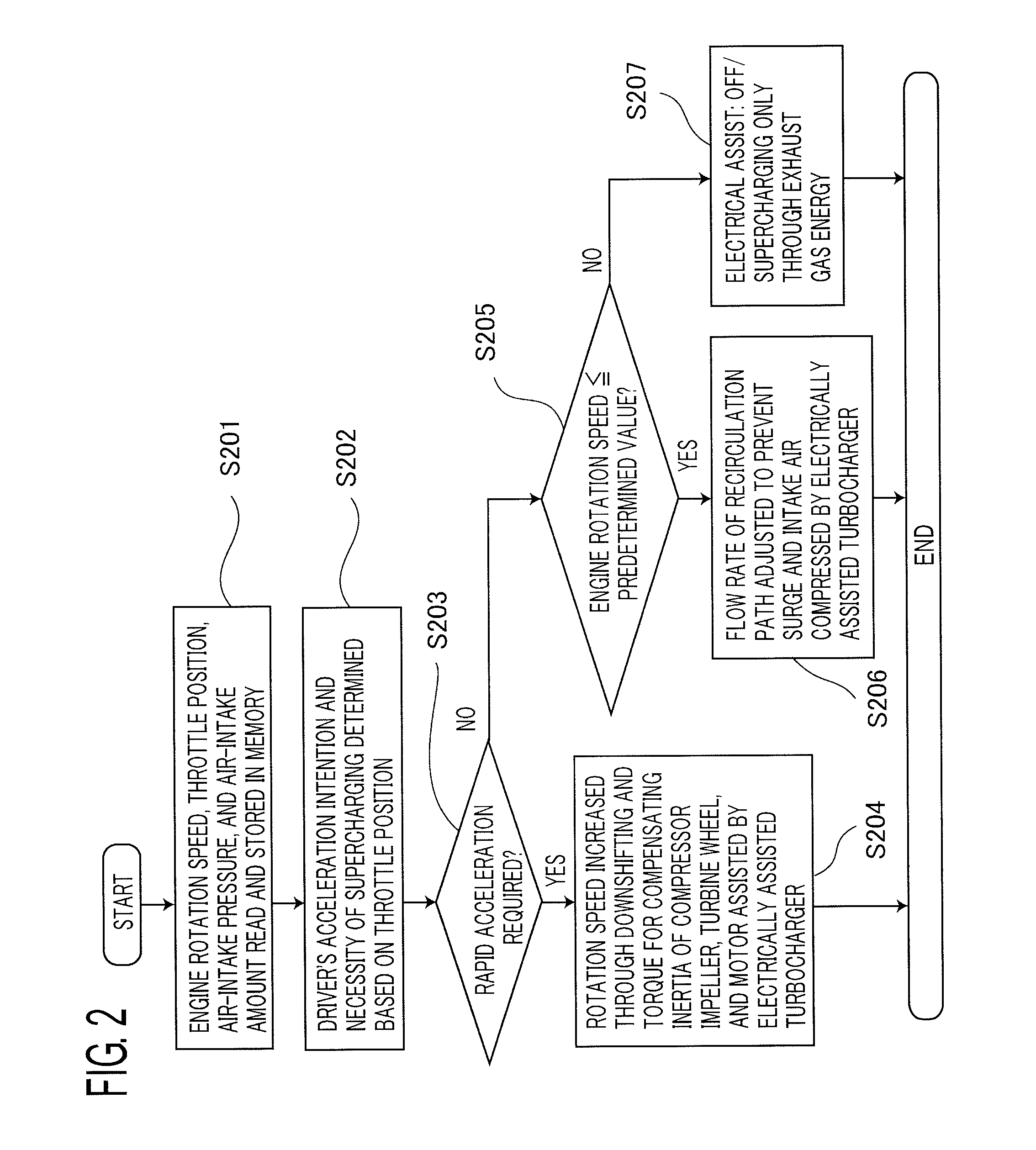[0008]The present invention has been implemented in order to solve the foregoing problems in the conventional apparatuses; the objective thereof is to obtain an internal-combustion-engine control apparatus in which the
power consumption of an electrically assisted turbocharger is reduced and the electrically assisted turbocharger can perform desired supercharging.
[0010]Moreover, an internal-combustion-engine control apparatus according to the present invention is provided with an electrically assisted turbocharger including a
turbine wheel that is provided in an exhaust path of an internal combustion engine mounted in a vehicle and is driven with
exhaust gas energy of the internal combustion engine, a compressor
impeller that is provided in an air-intake path of the internal combustion engine and is driven by the
turbine wheel so as to compress the air in the air-intake path, and a motor that exerts assisting torque on the compressor
impeller, as may be necessary and a control means that controls the electrically assisted turbocharger, based at least on an acceleration intention of a driver who drives the vehicle and a rotation speed of the internal combustion engine; the internal-combustion-engine control apparatus is characterized in that output torque of the internal combustion engine is increased by supercharging the internal combustion engine with air compressed by the compressor impeller; and in the case where the acceleration intention is not to require acceleration that is more rapid than a predetermined value and the rotation speed is the same as or lower than a predetermined rotation speed, the control means controls the motor in such a way that the motor drives the compressor impeller with assisting torque thereof, and in the case where the acceleration intention is not to require acceleration that is more rapid than the predetermined value and the rotation speed is higher than the predetermined rotation speed, the control means de-energizes the motor so that the compressor impeller is driven only with torque of the
turbine wheel.
[0013]In the internal-combustion-engine control apparatus according to the present invention, there are preferably included a recirculation path for returning air at the downstream side of the compressor impeller in the air-intake path to the upstream side of the compressor impeller and an air flow rate adjusting means that controls the ratio of an air pressure at the downstream side of the compressor impeller to an air pressure at the upstream side of the compressor impeller by adjusting an air flow rate in the recirculation path; the air flow rate adjusting means adjusts an air flow rate in the recirculation path, based at least on an air pressure at the downstream side of the compressor impeller and the assisting torque of the motor. In this case, the air flow rate adjusting means adjusts the flow rate of air that recirculates through the recirculation path, so that there can be prevented a surge that is caused through the compression of air by the compressor impeller.
[0016]In an internal-combustion-engine control apparatus according to the present invention, there is provided a control means that controls the electrically assisted turbocharger, based at least on an acceleration intention of a driver who drives the vehicle; when the acceleration intention is to require acceleration that is more rapid than a predetermined value, the control means controls the motor in such a way that the motor generates assisting torque for compensating
inertia moments of at least the
turbine wheel, the compressor impeller, and the motor. As a result, it is made possible that the
power consumption of the electrically assisted turbocharger is reduced and the electrically assisted turbocharger can perform desired supercharging; therefore, there can be carried out the downsizing of an internal combustion engine, which cannot be realized by a turbocharger that is driven only with exhaust gas energy.
[0017]Moreover, in an internal-combustion-engine control apparatus according to the present invention, there is provided a control means that controls the electrically assisted turbocharger, based at least on an acceleration intention of a driver who drives the vehicle and a rotation speed of the internal combustion engine; in the case where the acceleration intention is not to require acceleration that is more rapid than a predetermined value and the rotation speed is the same as or lower than a predetermined rotation speed, the control means controls the motor in such a way that the motor drives the compressor impeller with assisting torque thereof, and in the case where the acceleration intention is not to require acceleration that is more rapid than the predetermined value and the rotation speed is higher than the predetermined rotation speed, the control means de-energizes the motor so that the compressor impeller is driven only with torque of the
turbine wheel. As a result, it is made possible that the power consumption of the electrically assisted turbocharger is reduced and the electrically assisted turbocharger can perform desired supercharging; therefore, there can be carried out the downsizing of an internal combustion engine, which cannot be realized by a turbocharger that is driven only with exhaust gas energy.
[0018]Still moreover, in an internal-combustion-engine control apparatus according to the present invention, there is provided a control means that controls the electrically assisted turbocharger, based at least on a rotation speed of the internal combustion engine; when the output torque of the internal combustion engine is increased at a more higher rotation speed than a predetermined rotation speed of the internal combustion engine, the control means controls the motor in such a way that the motor generates assisting torque for compensating
inertia moments of at least the turbine wheel, the compressor impeller, and the motor. As a result, it is made possible that the power consumption of the electrically assisted turbocharger is reduced and the electrically assisted turbocharger can perform desired supercharging; therefore, there can be carried out the downsizing of an internal combustion engine, which cannot be realized by a turbocharger that is driven only with exhaust gas energy.
 Login to View More
Login to View More  Login to View More
Login to View More 


